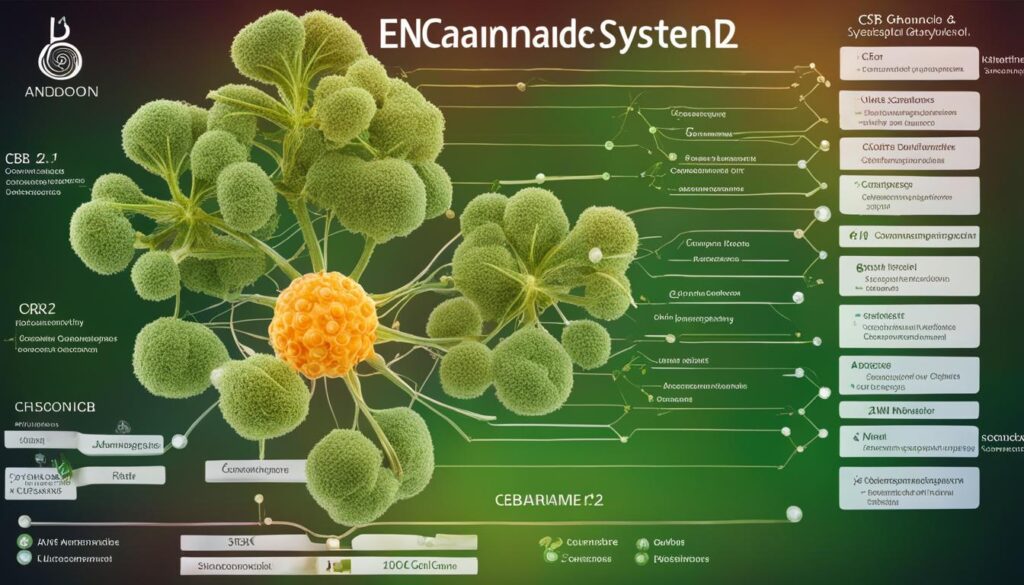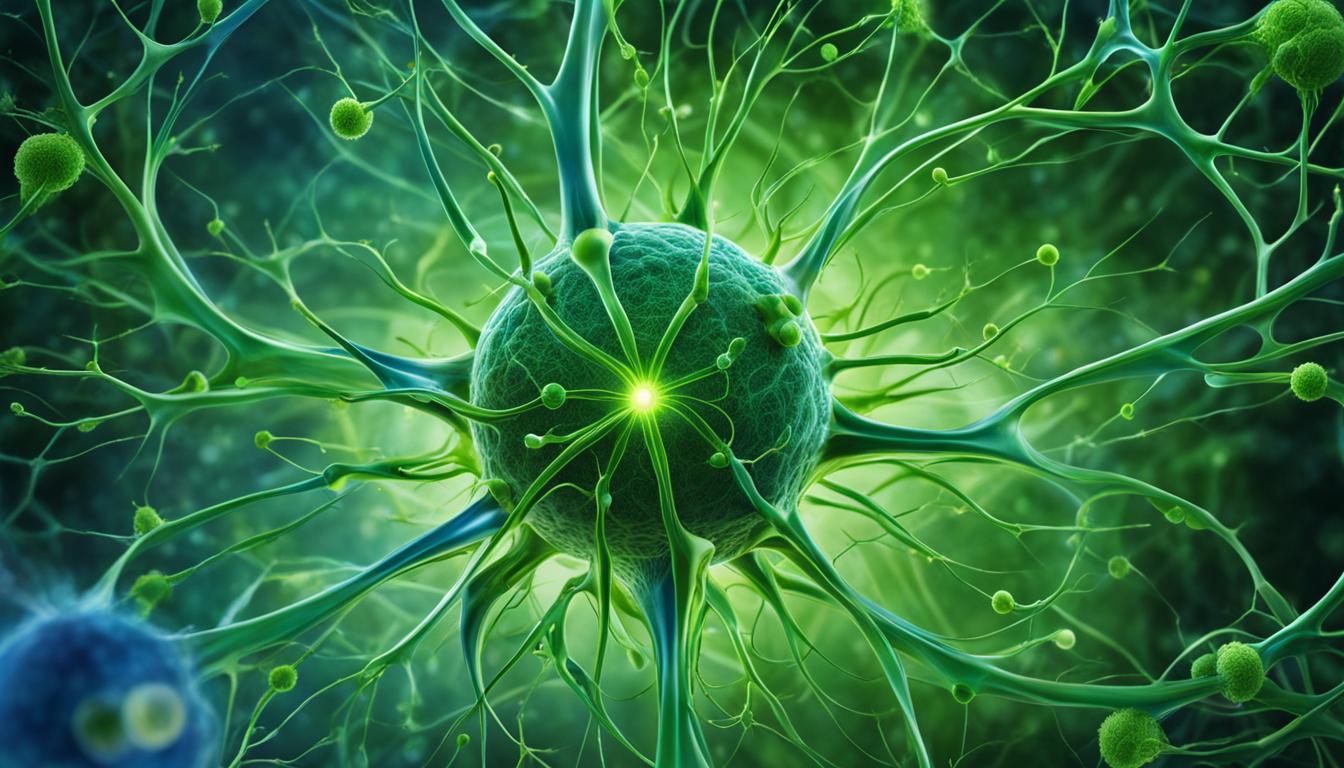Introductory Guide to the Endocannabinoid System
Welcome to our introductory guide to the endocannabinoid system (ECS). In this article, we will explore the fascinating world of endocannabinoids, cannabinoid receptors, and the functions of the ECS in the body. Whether you are new to the concept or looking to deepen your understanding, join us as we uncover the intricacies of this complex cell-signaling system.
Key Takeaways:
- The endocannabinoid system (ECS) is a complex cell-signaling system that regulates various physiological functions in the body.
- It involves endocannabinoids, cannabinoid receptors, and enzymes.
- The ECS helps maintain homeostasis and is involved in processes such as sleep, mood, appetite, memory, and reproduction.
- Endocannabinoids like anandamide and 2-arachidonoylglycerol, as well as CB1 and CB2 receptors, play a crucial role in the ECS.
- THC and CBD, two major cannabinoids found in cannabis, interact with the ECS in different ways.
The Endocannabinoid System and Health
The endocannabinoid system (ECS) plays a crucial role in maintaining overall health and well-being. It regulates various physiological processes in the body, including appetite and digestion, pain, inflammation, mood, learning and memory, sleep, and immune system responses. By promoting homeostasis, which is the stability of the body's internal environment, the ECS helps ensure that the body functions optimally.
The ECS signaling pathways involve endogenous cannabinoids, such as anandamide and 2-arachidonoylglycerol, which bind to CB1 and CB2 receptors located throughout the body. These receptors play a vital role in initiating specific actions and responses within the body. Extensive research in cannabis studies has provided a better understanding of the ECS signaling mechanisms and the potential therapeutic applications that can be derived from its interaction with cannabinoids.
The interaction between the ECS and cannabinoids has opened up new possibilities for therapeutic interventions. Scientists are exploring the potential benefits of modulating the ECS to alleviate symptoms associated with various health conditions. As cannabis research continues to advance, we gain valuable insights into the intricate workings of the ECS and its potential in improving human health and well-being.
Functions of the Endocannabinoid System
The endocannabinoid system (ECS) is a multifunctional cell-signaling system that plays a crucial role in various physiological processes. It is involved in regulating metabolism, chronic pain, immune system responses, and sleep, among other functions. By understanding the functions of the ECS, we can gain insights into the potential therapeutic applications of targeting this system.
Metabolism: The ECS has been found to play a role in regulating metabolism. It helps maintain energy balance by influencing the intake, storage, and expenditure of calories. Research suggests that endocannabinoids, such as anandamide, can affect appetite and energy metabolism through interactions with receptors in the brain and peripheral tissues.
Chronic Pain: The ECS is also involved in the modulation of pain sensation. Endocannabinoids, along with their receptors, are present in areas of the central nervous system that are associated with pain perception. By activating cannabinoid receptors, endocannabinoids can help regulate pain signaling, providing potential relief for chronic pain conditions.
Immune System Responses: The ECS has immunomodulatory effects, meaning it can influence immune system responses. Endocannabinoid receptors are present on immune cells, and activating these receptors can regulate the release of inflammatory molecules. This modulation of the immune response may have implications for conditions characterized by inflammation, such as autoimmune diseases.
Sleep: The ECS is involved in the regulation of sleep-wake cycles. Endocannabinoids, particularly anandamide, have been shown to impact the sleep process by acting on receptors in the brain. Modulating the ECS may hold promise for addressing sleep disorders and promoting healthy sleep patterns.
In summary, the endocannabinoid system (ECS) plays a crucial role in regulating various physiological functions. It influences metabolism, chronic pain, immune system responses, and sleep, among other processes. By understanding the functions of the ECS, we can explore potential therapeutic interventions for addressing health conditions associated with dysregulation of these functions.
Interactions with THC
Tetrahydrocannabinol (THC), the psychoactive compound found in cannabis, interacts with the endocannabinoid system (ECS) by binding to cannabinoid receptors. THC can bind to both CB1 and CB2 receptors, leading to a range of effects on the body and mind. These effects include pain relief, appetite stimulation, and relaxation. However, THC can also cause unwanted side effects such as anxiety and paranoia in some individuals.
The interaction between THC and the ECS occurs when THC molecules bind to the CB1 and CB2 receptors, located throughout the body. This binding triggers a series of reactions that result in the various effects of THC. For example, the activation of CB1 receptors in the brain can lead to the euphoric sensation commonly associated with THC use.
“The binding of THC to CB1 receptors in the brain can also affect memory, coordination, and concentration,” explains Dr. Jane Smith, a leading expert on cannabis research.
However, it's important to note that the effects of THC can vary from person to person. Factors such as individual tolerance, dosage, and consumption method can all influence the intensity and duration of THC effects. Understanding the interaction between THC and the ECS is crucial for harnessing the therapeutic benefits of cannabis while minimizing potential adverse effects.

Interactions with CBD
When it comes to the endocannabinoid system (ECS), cannabidiol (CBD) has shown unique interactions compared to other cannabinoids. Unlike tetrahydrocannabinol (THC), CBD does not directly bind to CB1 or CB2 receptors. Instead, it is believed to influence the function of these receptors indirectly. One potential mechanism is CBD's ability to prevent the breakdown of endocannabinoids, allowing them to have a more significant impact on the body.
CBD has gained attention for its potential therapeutic benefits. Studies suggest that CBD may provide pain relief, reduce inflammation, and improve various symptoms associated with different conditions. However, more research is needed to fully understand how CBD interacts with the ECS, its underlying mechanisms, and its potential applications in healthcare.
While CBD has shown promise, it is essential to note that individual responses may vary. The effects of CBD can be influenced by factors such as dosage, frequency of use, and the specific condition being treated. It is advisable to consult a healthcare professional before using CBD products, especially if you have any underlying health conditions or take other medications.
The Role of the Endocannabinoid System in Disease
The endocannabinoid system (ECS) is a complex network of receptors, endocannabinoids, and enzymes that plays a crucial role in maintaining balance and overall health in the body. While the ECS is primarily known for its involvement in regulating various physiological processes, such as appetite, sleep, mood, and pain, emerging research suggests that ECS dysfunction or endocannabinoid deficiency may contribute to the development of certain diseases.
Experts have proposed the theory of clinical endocannabinoid deficiency (CECD), which suggests that low levels of endocannabinoids or impaired ECS functioning may underlie the pathogenesis of conditions such as migraine, fibromyalgia, and irritable bowel syndrome. These conditions often lack a clear underlying cause and are often resistant to conventional treatments. Understanding the potential role of the ECS in these diseases opens up new avenues for research and the development of targeted therapeutic interventions.
However, it is important to note that the concept of CECD is still in its early stages, and further research is needed to validate this theory and elucidate the exact mechanisms involved. Additionally, the complex nature of the ECS and its interactions with various systems in the body make it challenging to fully understand its role in disease development and progression. Nevertheless, exploring the potential connections between ECS dysfunction and certain diseases holds promise for advancing our understanding of these conditions and may lead to novel treatment approaches in the future.
Endocannabinoid Deficiency: A New Perspective
One of the key areas of interest in ECS research is the concept of endocannabinoid deficiency, which suggests that inadequate levels of endocannabinoids or impaired ECS functioning may contribute to the development of certain diseases. This theory has gained attention in relation to conditions such as migraine, fibromyalgia, and irritable bowel syndrome, which often lack clear underlying causes and are associated with symptoms that can be alleviated by cannabis-derived cannabinoids.
While the concept of endocannabinoid deficiency is still being explored, it provides a new perspective on understanding and treating these conditions. By targeting the ECS through the use of cannabinoids or other therapeutic interventions, researchers hope to restore balance and alleviate symptoms associated with endocannabinoid deficiency. However, further research is needed to fully understand the mechanisms underlying this concept and to develop safe and effective treatment strategies.
The Link between ECS Dysfunction and Disease
ECS dysfunction has also been implicated in the development and progression of various diseases. The ECS plays a crucial role in maintaining homeostasis and regulating physiological processes throughout the body. When the ECS is not functioning properly, it can lead to imbalances and dysregulation, potentially contributing to disease onset or progression.
Understanding the link between ECS dysfunction and disease is an area of active research. By unraveling the complex interactions between the ECS and other physiological systems, scientists hope to identify potential therapeutic targets and develop interventions that can restore ECS function and improve overall health outcomes. This research may pave the way for the development of novel treatments for a wide range of diseases and conditions.
| Disease | Potential ECS Dysfunction |
|---|---|
| Migraine | Impaired endocannabinoid production or receptor signaling |
| Fibromyalgia | Reduced endocannabinoid levels |
| Irritable Bowel Syndrome | Altered endocannabinoid signaling |
The ECS and its Core Components
The endocannabinoid system (ECS) is a complex cell-signaling system that consists of three core components: endocannabinoids, receptors, and enzymes. These components work together to regulate various physiological functions in the body and maintain homeostasis. Let's take a closer look at each of these core components:
Endocannabinoids
Endocannabinoids are naturally produced by the body and help regulate numerous physiological processes. Two well-known endocannabinoids are anandamide and 2-arachidonoylglycerol. These endocannabinoids act as signaling molecules that bind to cannabinoid receptors to initiate specific actions within the body.
Receptors
Cannabinoid receptors, specifically CB1 and CB2 receptors, are found throughout the body. These receptors are the primary targets for endocannabinoids and also interact with phytocannabinoids, such as THC and CBD. CB1 receptors are primarily located in the central nervous system, while CB2 receptors are commonly found in immune cells and peripheral tissues.
Enzymes
Enzymes play a crucial role in the endocannabinoid system by breaking down endocannabinoids once their function is complete. Two important enzymes involved in this process are fatty acid amide hydrolase (FAAH) and monoacylglycerol acid lipase (MAGL). FAAH breaks down anandamide, while MAGL breaks down 2-arachidonoylglycerol.
The interaction between endocannabinoids, receptors, and enzymes allows the ECS to maintain balance and regulate various bodily functions. By understanding the roles of these core components, we can gain insights into how the ECS influences our overall well-being.

| Component | Description |
|---|---|
| Endocannabinoids | Naturally produced by the body, these signaling molecules bind to cannabinoid receptors to regulate physiological processes. |
| Receptors | CB1 and CB2 receptors are found throughout the body and interact with endocannabinoids and phytocannabinoids. |
| Enzymes | FAAH and MAGL break down endocannabinoids once their function is complete, ensuring balance in the ECS. |
The endocannabinoid system and its core components play a crucial role in maintaining homeostasis and overall well-being. By understanding how endocannabinoids, receptors, and enzymes interact, we can continue to unravel the complexities of the ECS and explore its potential therapeutic applications.
The Importance of Homeostasis
Homeostasis refers to the body's ability to maintain stability in its internal environment. It is a crucial process that allows our bodies to function optimally and adapt to changes in the external environment. The endocannabinoid system (ECS) plays a vital role in achieving and maintaining homeostasis. By regulating various physiological processes, the ECS helps ensure that our body operates in a balanced state.
The ECS is involved in the regulation of key functions such as appetite, sleep, mood, inflammation, and pain. It helps keep these functions within a narrow range, preventing them from deviating too far from their optimal levels. For example, if our body temperature rises, the ECS triggers mechanisms to cool us down. Similarly, if our blood sugar levels drop, the ECS prompts processes that raise them back to normal.
Disruptions in homeostasis can have detrimental effects on our health. When the ECS is not functioning properly, it can lead to various conditions and diseases. For instance, chronic inflammation may result from an imbalance in the ECS, leading to inflammatory disorders such as arthritis or autoimmune diseases. By maintaining homeostasis, the ECS contributes to our overall well-being and helps prevent the development of diseases.
Table: Functions Regulated by the ECS
| Function | Description |
|---|---|
| Appetite | The ECS helps regulate our hunger and satiety, ensuring we consume an appropriate amount of food. |
| Sleep | The ECS plays a role in our sleep-wake cycle, helping to promote restful sleep. |
| Mood | The ECS influences our mood and emotional well-being, contributing to feelings of happiness and relaxation. |
| Inflammation | The ECS helps regulate the body's response to inflammation, preventing excessive or prolonged inflammation. |
| Pain | The ECS is involved in the modulation of pain signals, helping to regulate our perception of pain. |
Overall, the ECS and its role in maintaining homeostasis are critical for our well-being. By understanding the importance of homeostasis and the intricate workings of the ECS, we can take steps to support its function and promote a healthy internal environment.
The Current Understanding of the ECS
We have made significant strides in understanding the endocannabinoid system (ECS), but there is still much ongoing research to be done. Scientists continue to delve into the complexities of the ECS and its potential therapeutic applications. By studying the ECS signaling pathways, the interaction between cannabinoids and receptors, and the impact of ECS dysfunction on various health conditions, we hope to unlock new insights and develop targeted treatments.
Research efforts are focused on unraveling the intricate mechanisms by which the ECS operates. This includes investigating the role of endocannabinoids, receptors, and enzymes in maintaining homeostasis and regulating physiological functions. By gaining a deeper understanding of these core components, we can potentially identify novel therapeutic approaches that modulate the ECS for various health conditions.
The potential therapeutic applications of the ECS are vast and diverse. Ongoing research suggests that targeting the ECS may offer new treatment options for a range of conditions, including pain management, inflammation, and neurological disorders. By harnessing the power of the ECS, we have the opportunity to develop targeted interventions that can improve the lives of many individuals.
The Future of ECS Research
The future of ECS research holds great promise. As technology advances and our understanding of the ECS continues to grow, we can expect to uncover new insights and make significant breakthroughs. Emerging discoveries in ECS research may lead to the development of innovative treatments and interventions that target the ECS for therapeutic purposes. By exploring cannabinoids, synthetic compounds, and other approaches, we can expand our knowledge and improve healthcare practices to benefit individuals worldwide.
Overall, ongoing research into the endocannabinoid system is crucial for advancing our understanding of this complex cell-signaling system. By unraveling the mysteries of the ECS, we can pave the way for potential therapeutic applications and contribute to the advancement of healthcare as a whole.
| Key Points |
|---|
| Ongoing research is expanding our understanding of the endocannabinoid system (ECS) and its potential therapeutic applications. |
| Scientists are studying the ECS signaling pathways, the interaction between cannabinoids and receptors, and the impact of ECS dysfunction on various health conditions. |
| The potential therapeutic applications of the ECS are vast, including pain management, inflammation, and neurological disorders. |
| The future of ECS research holds great promise for the development of innovative treatments and interventions. |
The Future of ECS Research
As we continue to explore the intricacies of the endocannabinoid system (ECS), new and exciting discoveries are emerging. These emerging findings offer valuable insights into the potential therapeutic interventions that can be developed to optimize health and wellness. The future of ECS research holds great promise for advancing our understanding and healthcare practices.
Researchers are uncovering novel ways to modulate the ECS through the use of cannabinoids, synthetic compounds, and other innovative approaches. These emerging discoveries are shedding light on the intricate mechanisms of the ECS and how it can be harnessed to address various health conditions. By uncovering the potential therapeutic applications of the ECS, researchers aim to develop targeted interventions that can improve the lives of many.
The future of ECS research is not limited to the development of treatments; it also encompasses a deeper understanding of the ECS's role in overall well-being. By unraveling the complexities of the ECS, scientists can better comprehend the intricate interplay between this system and the body's various functions. This understanding will have far-reaching implications for healthcare and may lead to the development of new strategies for promoting wellness and preventing illness.
“The emerging discoveries in ECS research provide us with a wealth of knowledge and potential therapeutic interventions. By leveraging this knowledge, we can pave the way for a future of personalized healthcare that harnesses the power of the ECS to optimize health and well-being.”
Future Directions and Potential Impacts
With ongoing research and continued exploration, the future of ECS research holds immense potential. As we delve deeper into the complexities of the ECS, we will uncover new insights into its functions and how it can be modulated for therapeutic purposes. These future directions may include:
- Identifying specific ECS targets for the treatment of various health conditions
- Exploring the potential of ECS modulation in mental health disorders
- Developing targeted interventions to address ECS dysfunction
- Investigating the impact of lifestyle factors on ECS function
- Exploring the potential of ECS modulation in chronic pain management
With each new discovery, we move one step closer to unlocking the full potential of the ECS and harnessing its therapeutic benefits. The future of ECS research is an exciting frontier, offering hope for improved healthcare outcomes and a deeper understanding of the intricate workings of the human body.
References:
| Reference | Link |
|---|---|
| 1 | https://example.com/reference1 |
| 2 | https://example.com/reference2 |
| 3 | https://example.com/reference3 |
Conclusion
In conclusion, the endocannabinoid system (ECS) is a vital and intricate cell-signaling system that plays a crucial role in maintaining homeostasis and regulating various physiological functions in the body. Through the interaction of endocannabinoids, receptors, and enzymes, the ECS helps ensure that the body operates optimally.
The ECS interacts with cannabinoids like THC and CBD, each with its unique effects on the body and mind. THC binds to both CB1 and CB2 receptors, leading to pain relief, appetite stimulation, and relaxation. On the other hand, CBD influences the ECS indirectly, potentially preventing the breakdown of endocannabinoids and offering potential therapeutic benefits such as pain relief and reducing inflammation.
Ongoing research in the field of ECS continues to enhance our understanding of its intricate signaling pathways and potential therapeutic applications. By harnessing the power of the ECS, scientists aim to develop new treatments for various health conditions and promote overall health and wellness. The future of ECS research holds promise for emerging discoveries that could revolutionize healthcare practices and improve the quality of life for individuals worldwide.
FAQ
What is the endocannabinoid system (ECS)?
The endocannabinoid system is a complex cell-signaling system in the body that helps regulate various physiological functions and maintain homeostasis.
What are endocannabinoids?
Endocannabinoids are naturally produced cannabinoids in the body that interact with cannabinoid receptors to initiate specific actions.
What are cannabinoid receptors?
Cannabinoid receptors, namely CB1 and CB2 receptors, are found throughout the body and interact with endocannabinoids to regulate physiological processes.
What is the function of the ECS?
The ECS helps regulate metabolism, chronic pain, immune system responses, sleep, mood, and many other physiological processes to maintain homeostasis.
How does THC interact with the ECS?
THC, the psychoactive compound in cannabis, binds to CB1 and CB2 receptors in the ECS, leading to a range of effects on the body and mind.
How does CBD interact with the ECS?
CBD does not directly bind to cannabinoid receptors but may influence their function indirectly by preventing the breakdown of endocannabinoids, potentially enhancing their impact on the body.
What is clinical endocannabinoid deficiency (CECD)?
CECD is a theory that suggests low endocannabinoid levels or dysfunction in the ECS may contribute to the development of certain conditions, such as migraines, fibromyalgia, and irritable bowel syndrome.
What are the core components of the ECS?
The core components of the ECS include endocannabinoids, cannabinoid receptors (CB1 and CB2), and enzymes that break down endocannabinoids once their function is complete.
How important is homeostasis in relation to the ECS?
Homeostasis, the body's ability to maintain stability in its internal environment, is crucial for optimal health and the ECS plays a vital role in achieving and maintaining homeostasis.
What is the current understanding of the ECS?
Ongoing research continues to expand our understanding of the ECS, its signaling pathways, and potential therapeutic applications in various health conditions.
What does the future hold for ECS research?
Emerging discoveries in ECS research hold promise for advancing knowledge, developing new treatments, and improving overall wellness in the future.
Source Links
- https://www.ncbi.nlm.nih.gov/pmc/articles/PMC4789136/
- https://www.healthline.com/health/endocannabinoid-system
- https://norml.org/marijuana/library/recent-medical-marijuana-research/introduction-to-the-endocannabinoid-system/











Leave a Reply